Romantic Nature
Today, we look closely at Romantic nature. The University of Houston presents this series about the machines that make our civilization run, and the people whose ingenuity created them.
One of the best-known poems of British Romanticism is “Ode to a Skylark,” an 1820 work by Percy Bysshe Shelley. “Hail to thee, blithe spirit!,” the poem begins, as Shelley calls out to the songbird, whose beautiful trill he loves to hear. Praising the skylark’s sound as a “flood of rapture,” Shelley’s admiration for the songbird shows both his love of nature and how nature inspires his own poetry.
.jpg)
Manuscript page of "To a Skylark" by Percy Bysshe Shelley (1792-1822). MS Eng 258.2, Houghton Library, Harvard University
Romantic poetry is often called nature poetry, because so many of its best-known works are about nature. Wordsworth rhapsodized about rainbows, daffodils and mountain walks. Coleridge wrote about an Aeolian harp, a kind of wind chime that makes music from the breeze. One of Keats’s greatest poems, "Ode to a Nightingale," is also about a songbird. Like Shelley hailing the skylark’s song, all these poets’ words help us appreciate nature.
But in celebrating nature’s beauty, the Romantic poets also document a world in which nature was under threat. When these poets lived in the late eighteenth and early nineteenth century, walls and property restrictions were enclosing the wide-open fields that Wordsworth loved. Industrial refuse was clouding skies and polluting waters, and cities were bursting with people with little experience in nature’s idyll. Romantic poetry, we start to understand, is nature poetry not just because poets were inspired by nature. By writing about nature, these poets’ words substitute for the actual nature then rapidly disappearing.
By contrast, the bird poems of self-taught farmer poet, John Clare, offer a much more clear-eyed glimpse of the changing landscape. Unlike Shelley and his cohort, Clare was a tenant farmer with little formal education. Poor throughout his life, Clare made his own ink by boiling roots and leaves. But his daily labor in nature, unlike the idealized visions of his more privileged counterparts, reveals Clare’s acute sense of the natural world around him.

Portrait of John Clare, by William Hilton, 1820. National Portrait Gallery, Britain
“Birds, why are ye silent?,” asks Clare in his poem of the same name. Wondering why he doesn’t hear any songbirds, Clare calls out to redbreast, hedge sparrow, chaffinch, bullfinch, yellow-hammers, blackbird, tree-creeper, feed sparrow, wren, robins and larks. His long list of specific birds shows both his deep knowledge of nature and his fear that something is harming it. Instead of using poetry to idealize a nature fast disappearing, Clare reminds listeners that nature is our responsibility and gift.
More than a century after John Clare, environmentalist Rachel Carson borrowed from the Romantic poets for the title of her important 1962 book, "Silent Spring." A study about the ecological damage wrought by pesticides, "Silent Spring" also uses the absence of birdsong to urge environmental protections.

Now, decades later, as continuing ecological destruction causes bird populations to decline at alarming rates, Romantic poetry still reminds us of the priceless gift of nature. Great writing doesn’t just help us see nature better. The best writing also reminds us to listen, and in listening we uphold our responsibility to nature.
I’m Karen Fang, at the University of Houston, where we’re interested in the way inventive minds work.
Raymond Williams, The Country and City, New York: Oxford, 1973
Jonathan Bate, John Clare: A Biography, New York: Farrar, Strauss, and Giroux, 2003
This episode was first aired April 8, 2025.